The Kara-Khanid Khanate, also known as the Karakhanids, Qarakhanids, Ilek Khanids or the Afrasiabids, was a Karluk Turkic khanate that ruled Central Asia in the 9th through the early 13th century. The dynastic names of Karakhanids and Ilek Khanids refer to royal titles with Kara Khagan being the most important Turkic title up until the end of the dynasty.
The Ghaznavid dynasty or the Ghaznavid Empire was a Persianate Muslim dynasty and empire of Turkic mamluk origin, ruling at its greatest extent, large parts of Persia, Khorasan, and the northwest Indian subcontinent from 977 to 1186. The dynasty was founded by Sabuktigin upon his succession to the rule of Ghazna after the death of his father-in-law, Alp Tigin, who was an ex-general of the Samanid Empire from Balkh, north of the Hindu Kush in Greater Khorasan.

Abu Talib Muhammad Tughril ibn Mika'il, better known as Tughril, was a Turkoman chieftain, who founded the Seljuk Empire, ruling from 1037 to 1063.

The Anushtegin dynasty or Anushteginids, also known as the Khwarazmian dynasty was a Persianate Sunni Muslim dynasty of Turkic mamluk origin from the Bekdili clan of the Oghuz Turks. The Anushteginid dynasty ruled the Khwarazmian Empire, consisting in large parts of present-day Central Asia, Afghanistan and Iran in the approximate period of 1077 to 1231, first as vassals of the Seljuks and the Qara Khitai, and later as independent rulers, up until the Mongol conquest of the Khwarazmian Empire in the 13th century.

The Samanid Empire, also known as the Samanian Empire, Samanid dynasty, Samanid amirate, or simply as the Samanids, was a Persianate Sunni Muslim empire, of Iranian dehqan origin. The empire was centred in Khorasan and Transoxiana; at its greatest extent encompassing Persia and Central Asia, from 819 to 999.

Nuh II was amir of the Samanids (976–997). He was the son and successor of Mansur I.
Khwarazmshah was an ancient title used regularly by the rulers of the Central Asian region of Khwarazm starting from the Late Antiquity until the advent of the Mongols in the early 13th-century, after which it was used infrequently. There were a total of four families who ruled as Khwarazmshahs—the Afrighids (305–995), Ma'munids (995–1017), the line of Altuntash (1017–1041), and the most prominent ones, the Anushteginids (1097–1231). Like other contemporary Central Asian titles, such as Afshin and Ikhshid, the title of Khwarazmshah is of Iranian origin.

Ala al-Din wa-l-Dawla Abu'l-Muzaffar Atsiz ibn Muhammad ibn Anushtegin, better known as Atsiz (اتسز) was the second Khwarazmshah from 1127/8 to 1156. He was the son and successor of Muhammad I.
Abu al-Hasan 'Ali was ruler of Khwarazm from 997 until his death c. 1009. The second member of the Ma'munid dynasty, he was the son of Ma'mun I ibn Muhammad.
The Al-i Muhtaj or Muhtajids was an Iranian or Iranicized Arab ruling family of the small principality of Chaghaniyan. They ruled during the 10th and early 11th centuries.

Chaghaniyan, known as al-Saghaniyan in Arabic sources, was a medieval region and principality located on the right bank of the Oxus River, to the south of Samarkand.
Abu'l-Abbas Ma'mun ibn Ma'mun was the Ma'munid ruler of Khwarazm from 1009 until his death in 1017, having succeeded his brother Abu al-Hasan Ali in that post. He was the son of Ma'mun I ibn Muhammad.

The Afrighids were a native Khwarezmian Iranian dynasty who ruled over the ancient kingdom of Khwarezm. Over time, they were under the suzerainty of the Sasanian Empire, the Hephthalite Empire, the Göktürk Khaganate, the Umayyad Caliphate, Abbasid Caliphate and the Samanid Empire.

The Maʾmunids were an independent dynasty of Iranian rulers in Khwarazm. Their reign was short-lived (995–1017), and they were in turn replaced by the expansionist Ghaznavids.

Masʽud I of Ghazni, known as Amīr-i Shahīd, was sultan of the Ghaznavid Empire from 1030 to 1040. He rose to power by seizing the Ghaznavid throne from his younger twin Mohammad, who had been nominated as the heir upon the death of their father Mahmud of Ghazni. His twin was shortly blinded and imprisoned. However, when much of Masʽud's western domains had been wrested from his control, his troops rebelled against him and reinstated Mohammad to the throne.
The Khwarazmian or Khwarezmian Empire was a culturally Persianate, Sunni Muslim empire of Turkic mamluk origin. Khwarazmians ruled large parts of present-day Central Asia, Afghanistan, and Iran in the approximate period of 1077 to 1231, first as vassals of the Seljuk Empire and the Qara Khitai, and from circa 1190 as independent rulers, up until the Mongol conquest in 1219–1221.
Abuʾl-Ḥasan al-Qāsim Aḥmad ibn Ḥasan Maymandī was a Persian vizier of the Ghaznavid ruler Mahmud of Ghazni and the latter's son Mas'ud I of Ghazni.

Ali ibn Hasan, also known as Harun Bughra Khan and better known as Ali-Tegin was a Karakhanid ruler in Transoxiana from 1020 to 1034 with a brief interruption in 1024/25.
Böritigin, also known as Ibrahim ibn Nasr or Tamghach Khan Ibrahim, was a Karakhanid ruler in Transoxiana from 1038 to 1068. He was one of the greatest rulers of the dynasty.
Arslan Isra'il, also known as Arslan Yabgu was a Turkic chieftain, who was from the Kınık tribe, which would later establish the Seljuk Empire. His name Arslan means "the lion". Arslan was son of the warlord Seljuk and uncle to the founders of the Seljuk empire, Chaghri and Tughril.









